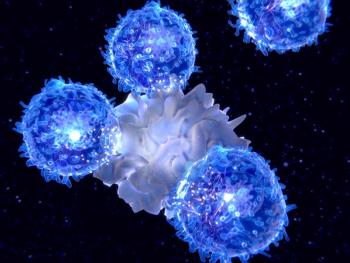
- ONCOLOGY Vol 14 No 3
- Volume 14
- Issue 3
Zevalin (IDEC-Y2B8) Radioimmunotherapy of Rituximab-Refractory Follicular Non-Hodgkin’s Lymphoma (NHL): Interim Results
Ibritumomab tiuxetan (Zevalin) is an anti-CD20 murine immunoglobulin G1 (IgG1) kappa monoclonal antibody conjugated to tiuxetan that forms a strong chelate with the pure beta-emitting isotope yttrium-90 (90Y). Mechanisms of action include
Ibritumomab tiuxetan (Zevalin) is an anti-CD20 murine immunoglobulin G1 (IgG1) kappa monoclonal antibody conjugated to tiuxetan that forms a strong chelate with the pure beta-emitting isotope yttrium-90 (90Y). Mechanisms of action include direct induction of apoptosis (Blood 88[10; suppl 1]:637a, 1996) and radiolysis.
Based on the phase I/II experience, we are conducting a nonrandomized, phase III, open-label clinical trial to evaluate the efficacy and safety of tiuxetan in follicular NHL patients refractory to rituximab (ie, those who did not achieve a response or had a TTP of < 6 months with the most recent course of rituximab, 375 mg/m² weekly × 4). Efficacy end points include overall response rate, duration of response, TTP, and comparison of overall response rate and duration to those achieved with prior therapy. Patients were excluded if they had more than 25% bone marrow involvement with NHL, > 5,000 circulating lymphocytes, or had received prior radioimmunotherapy.
An interim analysis was performed on the first 26 patients. Patient characteristics included: median age of 56 years, follicular histology (92% of patients), prior therapies (median, 3), bone marrow involvement (27% of patients), splenomegaly (12% of patients), bulky disease > 7 cm (46% of patients), and prior radiotherapy (31% of patients). All patients who underwent dosimetry (N = 23 in this interim analysis group) had acceptable biodistribution and estimated absorbed radiation doses to normal organs.
Toxicity was primarily hematologic, transient, and reversible. Median hematologic nadirs were a granulocyte count of 900 cells/mm³ platelets of 34,000 cells/mm³, and hemoglobin of 10.6 g/dL. Transient grade 4 thrombocytopenia and neutropenia occurred in 8% and 23% of patients, respectively. In these patients, median recovery of platelet and neutrophil counts occurred in 15 and 14 days, respectively.
Response classification was assigned by a LEXCOR (Lymphoma Expert Confirmation of Response) panel that was blinded to investigator designation of response. The overall response rate was 46% in the 24 follicular NHL patients for whom response data were available. Three patients were considered nonresponders, as their response had not been confirmed at ³ 28 days at the time of the interim analysis.
CONCLUSION: This interim analysis suggests that tiuxetan radioimmunotherapy is safe and effective in the treatment of patients with rituximab-refractory follicular NHL. Final conclusions await complete analysis.
Articles in this issue
almost 26 years ago
FHIT Gene, Smoking, and Cervical Canceralmost 26 years ago
IOM Medical Error Estimates Questioned, But Legislation Consideredalmost 26 years ago
Less Toxic Therapies for Hodgkin’s Disease May Reduce Secondary CancersNewsletter
Stay up to date on recent advances in the multidisciplinary approach to cancer.

















































































